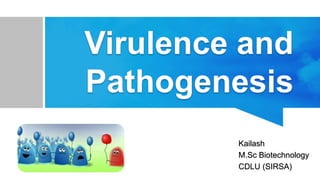
Virulence and pathogenesis (kailash)
- 2. Virulence • Virulence is defined by the ability of a microorganism to cause disease in the host. • The development of a disease and the chain of events leading to that disease is called Pathogenesis.
- 3. • Food can carry microorganisms that are virulent and are able to cause disease in the individuals who consume the food. • Microorganisms possess a number of different virulence mechanisms that help to evade host defenses, enter host cells, and disable or lyse the host cells.
- 4. • The consumer of the food, in turn, is protected by a number of components in the body including mucosal immunity. • Virulence mechanisms continue to evolve and be transferred among different microorganisms through a process known as lateral or horizontal gene transfer.
- 5. • The ability of bacteria to cause disease is described in terms of the number of infecting bacteria, the route of entry into the body, the effects of host defense mechanisms, and intrinsic characteristics of the bacteria called virulence factors. • Many virulence factors are so-called effector proteins that are injected into the host cells by special secretion machines such as the type 3 secretion system. (Type three secretion system is a protein appendage found in several Gram-negative bacteria).
- 6. • Host-mediated pathogenesis is often important because the host can respond aggressively to infection with the result that host defense mechanisms do damage to host tissues while the infection is being countered. • The virulence factors of bacteria are typically proteins or other molecules that are synthesized by enzymes. • These proteins are coded for by genes in chromosomal DNA, bacteriophage DNA or plasmids. Certain bacteria employ mobile genetic elements and horizontal gene transfer.
- 7. • Therefore, strategies to combat certain bacterial infections by targeting these specific virulence factors and mobile genetic elements have been proposed. Bacteria use quorum sensing to synchronise release of the molecules. These are all proximate causes of morbidity in the host.
- 8. Methods by which bacteria cause disease • Adhesion • Colonization • Invasion • Immune response inhibitors • Toxins
- 9. Adhesion • Many bacteria must first bind to host cell surfaces. • Many bacterial and host molecules that are involved in the adhesion of bacteria to host cells have been identified. • Often, the host cell receptors for bacteria are essential proteins for other functions. Due to presence of mucous lining and of anti-microbial substances around some host cells, it is difficult for certain pathogens to establish direct contact-adhesion.
- 10. • Different microorganism utilizes different structure for attachment. For examples; Staphylococcus mutans attaches to the surface of teeth by its sticky capsule. Other bacteria such as coli, Neisseria spp, Shigella attaches with the help of pilli. • Some examples of adhesions are: • Capsule • Pili • Hemagglutinin spike of viruses • Lipoteichoic acid • Biofilm producing glycocalyx
- 11. adhesion
- 12. Colonization • Some virulent bacteria produce special proteins that allow them to colonize parts of the host body. • Helicobacter pylori is able to survive in the acidic environment of the human stomach by producing the enzyme urease. • Colonization of the stomach lining by this bacterium can lead to gastric ulcers and cancer. The virulence of various strains of Helicobacter pylori tends to correlate with the level of production of urease.
- 13. colonization
- 14. Invasion • Some virulent bacteria produce proteins that either disrupt host cell membranes or stimulate their own endocytosis or macro-pinocytosis into host cells. • These virulence factors allow the bacteria to enter host cells and facilitate entry into the body across epithelial tissue layers at the body surface.
- 15. invasion
- 16. Immune response inhibitors Many bacteria produce virulence factors that inhibit the host's immune system defenses. For example, a common bacterial strategy is to produce proteins that bind host antibodies. The polysaccharide capsule of Streptococcus pneumoniae inhibits phagocytosis of the bacterium by host immune cells
- 17. Toxins • Some microorganism produces toxic chemical. • Toxins are of two types; exotoxin and endotoxin i. Exotoxin: • Toxins which are released outside the bacterial cell is called exotoxins • Exotoxin is protein in nature. • In general, exotoxins are highly toxic and lethal dose is low. • Both Gram Positive and Gram Negative bacteria produces exotoxin
- 18. • Some examples are: • Neurotoxin: Botulinum toxin; produced by Clostridium botulinum, tetanus toxin; produced by Clostridium tetani • Enterotoxin: cholera toxin; produced by Vibrio cholerae, heat stable and heat labile toxin; produced by coli • Cytotoxin: Dephtheria toxin; produced by Corynebacterium dephtheriae • Hemolysin: lyse RBCs • Leucosidin: lyse WBCs
- 19. ii. Endotoxin: • Toxins which are not released outside of bacteria cell is called endotoxin. • Lipopolysaccharide (LPS) present in outer membrane of Gram Negative bacterial cell wall is an example of endotoxin. • Endotoxin is less toxic than exotoxin and lethal dose is high. • Endotoxin causes infection or disease by inducing fever, blood poisoning and septic shock
- 20. THANKYOU
